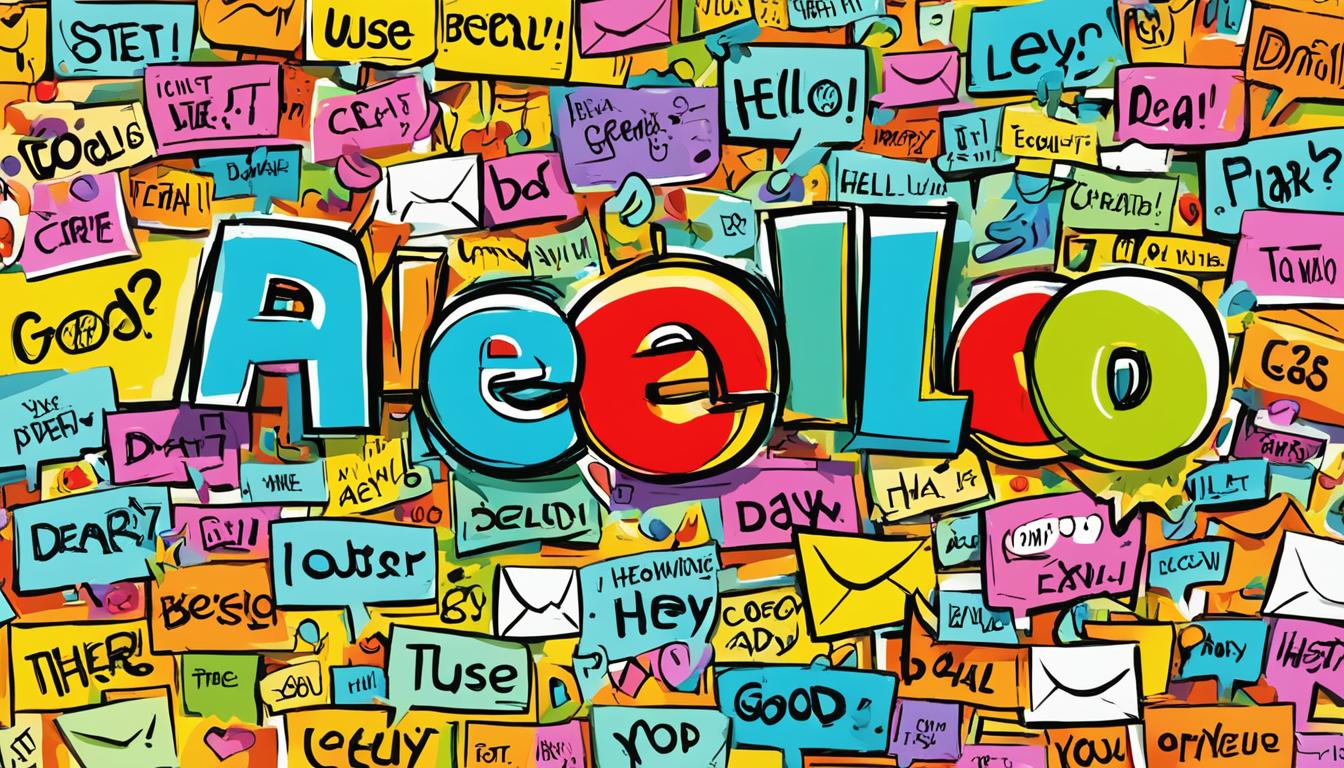When crafting professional email greetings, it’s essential to strike the right tone and make a positive impression right from the start. While the traditional salutation “Dear Sir or Madam” may have been widely used in the past, it is now considered outdated and impersonal.
In today’s digital age, it’s easy to personalize your email greetings and address the recipient in a more engaging and respectful manner. Using alternative words for ‘dear’ in email greetings can help create a professional and welcoming tone that reflects your effort and consideration.
One option is to start with “To Whom It May Concern” when you are unsure about the recipient’s name. Although it is a formal and neutral choice, it lacks the personal touch that can make your email more impactful. Instead, take the time to research and find the recipient’s name.
Another approach is to address the email to a specific team or department, such as “Hello, Marketing Team” or “Greetings, Human Resources.” This shows that you have taken the initiative to understand the recipient’s role and can help establish a connection right from the start.
Alternatively, you can simply use the recipient’s first name if you have a more informal relationship or if the situation allows for a casual tone. Starting with a friendly “Hi [Recipient’s Name]” or “Hello [Recipient’s Name]” creates a warmer and more approachable atmosphere.
By using these alternatives to ‘dear’ in email greetings, you can personalize your communication, show respect, and establish a positive rapport with the recipient. Whether it’s a formal business email or a professional correspondence, choosing the right words for your email greetings can make all the difference in building strong connections and leaving a lasting impression.
Why You Shouldn’t Use “Dear Sir or Madam”
In the digital age, where communication is swift and information is easily accessible, using the outdated and impersonal salutation “Dear Sir or Madam” in your email greetings can be problematic.
- Lack of effort and personalization: Starting an email with “Dear Sir or Madam” portrays a lack of effort and personalization. It shows that you haven’t taken the time and initiative to identify the recipient’s name, which can be easily found through LinkedIn or the company’s website.
- Exclusivity and assumption: Addressing someone with a generic salutation may offend or assume the gender identity of the recipient. With diverse gender identities and preferences, it’s crucial to be inclusive and respectful in your email greetings.
- Underlying issues: Using “Dear Sir or Madam” can signify a larger problem, such as sending bulk emails without personalization or not bothering to learn about the person you’re contacting. This can undermine the credibility of your email and hinder meaningful connections.
- Lack of familiarity: Starting an email with “Dear Sir or Madam” is akin to starting a conversation with a stranger. It fails to establish a friendly and familiar tone, which is essential to building rapport and creating a positive impression.
- More engaging alternatives: There are several alternatives to “Dear Sir or Madam” that are more personalized, engaging, and appropriate. By using the recipient’s first name or addressing specific teams or departments, you can make your email greetings more specific and tailored.
Replace the generic and rigid salutation with a more personalized and thoughtful approach to create a positive and effective email communication.
“Dear Sir or Madam” is a thing of the past. Embrace a more inclusive and engaging way to greet your email recipients.
Alternatives to “Dear Sir or Madam”
| Alternative | Usage |
|---|---|
| “To Whom It May Concern” | When the recipient’s name is unknown or when writing a formal letter to a specific department. |
| “Hello, [Insert team name]” | When addressing a specific team or department within an organization. |
| Using the recipient’s first name | A personalized and friendly option, especially when you have established a prior relationship or connection. |
https://www.youtube.com/watch?v=olk7bmsQhDQ
By embracing more personalized and engaging email greetings, you can set the tone for a productive and meaningful conversation right from the start.
Engaging Email Greetings and Opening Sentences
In today’s digital age, where emails flood our inboxes, it is crucial to grab the recipient’s attention right from the start. The email greeting and opening sentence play a key role in establishing a positive tone and encouraging the reader to continue reading.
An effective email greeting can be as simple as using the recipient’s first name, creating a sense of familiarity and personalization. Alternatively, informal greetings like “Hi” or “Hello” can help establish a friendly and approachable tone. If you are reaching out to a specific team or department, consider addressing them directly to show that you have done your research and are aware of their role within the organization.
Engaging opening sentences can set the stage for the rest of the email. Expressing gratitude for the recipient’s time or acknowledging any previous interactions can create a positive impression. Clearly stating the purpose of the email in the opening sentence ensures that the reader knows what to expect, avoiding any confusion or misunderstanding.
It is important to avoid stiff or impersonal salutations and opening sentences, such as the generic “To Whom It May Concern.” Remember, the goal is to establish a connection and create a memorable first impression. Additionally, be sure to double-check the recipient’s name for correct spelling and avoid any embarrassing mistakes.
To start an email effectively, tailor your introduction to your audience and make the purpose of the email clear. By crafting engaging email greetings and opening sentences, you set the stage for a successful email communication and increase the likelihood of a positive response.
FAQ
What are some alternatives to ‘Dear’ in email greetings?
Some alternatives to ‘Dear’ in email greetings include:
– “To Whom It May Concern”
– “Hello, [Insert team name]”
– Using the recipient’s first name
Why should I avoid using “Dear Sir or Madam” in formal emails?
Using “Dear Sir or Madam” in formal emails is outdated and lazy. It is important to personalize email greetings by finding out the recipient’s name. Additionally, using “Dear Sir or Madam” can be exclusive and may offend or assume the gender identity of the recipient.
How can I address someone in a cover letter without using a generic salutation?
When addressing someone in a cover letter, it is best to customize the salutation to the department or hiring manager instead of using a generic one like “Dear Sir or Madam.” Research and find out the correct name and title to use.
Are there drawbacks to using “Dear Sir or Madam” in email greetings?
Yes, there are drawbacks to using “Dear Sir or Madam.” It can be seen as lazy and lacking effort, especially in the digital age where information about the recipient can easily be found. Additionally, it is exclusive and may offend or assume the gender identity of the recipient.
What are some engaging ways to start an email?
Some engaging ways to start an email include:
– Using the recipient’s first name
– Using informal greetings like “Hi” or “Hello”
– Addressing specific teams or departments
– Expressing gratitude or acknowledging the recipient
Should I avoid stiff or impersonal salutations and opening sentences?
Yes, it is important to avoid stiff or impersonal salutations and opening sentences, such as “To Whom It May Concern” or using misspelled names. Personalization and a friendly tone are key to establishing a connection and encouraging the recipient to continue reading the email.
How can I tailor the email introduction to my audience?
To tailor the email introduction to your audience, consider the recipient’s relationship to you and the purpose of the email. Use a formal or informal tone accordingly, and make the purpose of the email clear to avoid confusion or misunderstanding.
Source Links
- https://blog.hubspot.com/sales/dear-sir-or-madam-alternatives
- https://www.videoform.com/blog/dear-sir-or-madam-alternatives/
- https://www.grammarly.com/blog/how-to-start-an-email/









